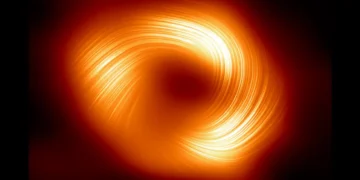Black holes, the enigmatic cosmic titans, never fail to captivate our imagination. These celestial phenomena have become laboratories for understanding the universe’s most extreme physics. The year 2024 was a landmark in black hole research, presenting discoveries that expanded our understanding of space, time, and gravity.
Why Black Holes Matter
Black holes are more than just gravitational traps—they are cosmic enigmas that challenge our understanding of physics. Their event horizons, where light and matter can’t escape, symbolize the ultimate mystery. At the center lies the singularity, a point where all known laws of physics cease to apply. This duality makes black holes both fascinating and crucial for testing the limits of scientific theories like general relativity. Understanding black holes also sheds light on galaxy formation, cosmic evolution, and the nature of spacetime.
The Seven Groundbreaking Discoveries of 2024
1. The Fastest-Growing Black Hole Devouring a Sun Daily
This year, astronomers identified the fastest-growing black hole ever observed, consuming an entire Sun’s mass daily. This distant black hole, powering the most luminous quasar ever detected, is a relic from the early universe. Spanning 17–19 billion times the mass of the Sun, its discovery illuminates how such massive entities formed during the universe’s infancy. The black hole’s insatiable appetite offers clues about the chaotic early cosmos, where gas and dust swirled into these massive voids at breakneck speeds.
2. Binary Stars Discovered Around Sagittarius A*
Astronomers detected binary stars orbiting close to Sagittarius A* (Sgr A*), the supermassive black hole at the heart of our Milky Way. Previously thought impossible due to Sgr A*’s intense gravitational forces, these stars are relatively young at 2.7 million years. Their survival challenges the assumption that such environments are too turbulent for binary systems. The discovery raises the exciting possibility that planets could form and exist near supermassive black holes, albeit temporarily.
3. The First Triple Black Hole System
Astronomers identified the first “black hole triple,” a system where a black hole feeds on a companion star while a distant star orbits the pair. Found within the V404 Cygni system, this discovery suggests that black holes can form without disrupting nearby stars. The system’s survival implies that black holes might emerge from less violent processes than previously thought. This finding is pivotal for understanding black hole formation and how they interact with their stellar companions.
4. Intermediate-Mass Black Holes Step into the Spotlight
Intermediate-mass black holes (IMBHs), long theorized as the “missing link” in black hole evolution, made headlines twice in 2024. One was discovered in Omega Centauri, a relic galaxy consumed by the Milky Way. Another lurked near Sagittarius A*, frozen in its growth due to a lack of cosmic “fuel.” These discoveries confirm the existence of IMBHs, bridging the gap between stellar-mass and supermassive black holes, and provide crucial insights into how black holes evolve across scales.
5. Gamma-Ray Flare from M87*
The Event Horizon Telescope (EHT), famous for imaging the first black hole, observed an explosive gamma-ray flare from M87*, a supermassive black hole 5.4 billion times the Sun’s mass. This unexpected eruption sheds light on the mechanics of black hole jets, streams of high-energy particles launched near light speed. The flare’s energy hints at how these jets contribute to cosmic phenomena, including the acceleration of particles that form cosmic rays reaching Earth.
6. Gaia Discovers a Massive Dormant Black Hole Close to Earth
The Gaia space telescope identified a stellar-mass black hole, BH3, just 2,000 light-years from Earth. With a mass 33 times that of the Sun, BH3 is the most massive stellar black hole found nearby. This discovery reinforces the idea that numerous dormant black holes may be hidden within the Milky Way. The realization that these sleeping giants exist undetected highlights the importance of advanced observational tools in uncovering the galaxy’s hidden secrets.
7. Polarized Light Observations of Sagittarius A*
The Milky Way’s supermassive black hole, Sagittarius A*, revealed new secrets when astronomers observed it in polarized light for the first time. These observations unveiled organized magnetic fields around the black hole, akin to those seen in M87*. This unexpected similarity raises the tantalizing possibility of a hidden jet within Sgr A*. The study’s findings pave the way for future explorations using instruments like the James Webb Space Telescope, promising even deeper insights into black hole behavior.
Why These Discoveries Are Groundbreaking
Technological Advancements
Breakthroughs in black hole research owe much to cutting-edge technology. Instruments like the Event Horizon Telescope, Gaia, and the Hubble Space Telescope have revolutionized our ability to observe distant phenomena. Techniques such as polarized imaging and gamma-ray detection enable scientists to delve into the intricate details of black hole mechanics. These tools are essential for capturing high-resolution data, turning theoretical models into observable science.
Scientific Impact
Each discovery adds a piece to the cosmic puzzle. The identification of IMBHs fills a critical gap in black hole evolution theories, while the gamma-ray flare offers direct evidence of high-energy processes near event horizons. Binary systems and triple black holes challenge assumptions about gravitational environments, prompting revisions of existing models. These findings collectively enhance our understanding of matter, energy, and the forces shaping the universe.
Broader Implications
Beyond astrophysics, these discoveries touch other scientific domains. Understanding black hole jets can illuminate the origins of cosmic rays, while insights into IMBHs contribute to galaxy formation studies. The identification of dormant black holes near Earth raises questions about their impact on local cosmic dynamics. Moreover, these breakthroughs inspire technological innovation, as researchers develop new instruments to probe the universe’s deepest mysteries.
Conclusion
The year 2024 will be remembered as a milestone in black hole research, offering discoveries that pushed the boundaries of human knowledge. From the ferocious appetite of a supermassive black hole to the quiet presence of dormant giants near Earth, each finding reshapes our understanding of these enigmatic entities. As we look forward to further exploration, one thing is certain: black holes will continue to intrigue and inspire, drawing humanity ever closer to the secrets of the cosmos.



















